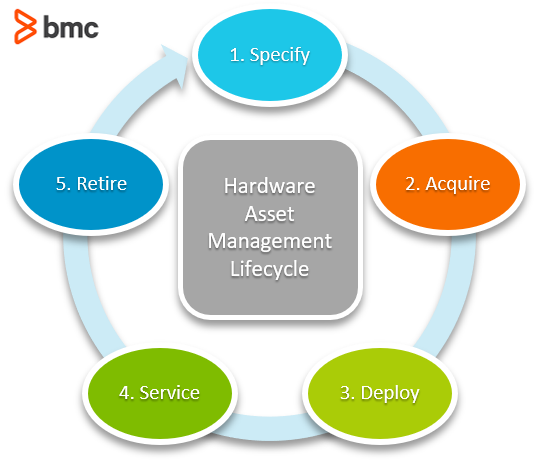In 1982, Alan Kay famously stated:
“People who are really serious about software should make their own hardware”.
And in this age of cloud and mobile, where we rarely interact with servers and network equipment, it might be easy to think they are no longer as useful as before.
But the hard truth is that good hardware remains the bedrock for all technology services. That’s why having an approach that effectively manages the lifecycle of hardware assets is critical, whether it’s for your own organization or for others, in a hosted arrangement.
Let’s explore hardware asset management and how it works for your organization.
(This article is part of our Sustainable IT Guide. Use the right-hand menu to explore topics related to sustainable technology efforts.)
Understanding & managing hardware assets?
An asset is any item, thing, or entity that has potential or actual value to an organization. That’s according to ISO.
Value here is about benefits for the organization:
- Value is usually financial in nature, as seen in the balance sheet, when an asset is used to generate revenue, reduce costs, or mitigate risk.
- Value can also be non-financial when it’s used well, such as customer satisfaction.
Hardware assets in IT service management refers to assets that are tangible in nature—those you can touch and feel. Hardware assets include those that are in use as well as those in storage.
Some examples of hardware assets, as listed in ITIL® 4, include:
- End-user devices: personal computers, laptops, tablets, smartphones, and SIM cards
- Network and telecom equipment: routers, switches, load balancers, and video- conferencing and voice over Internet protocol (VoIP) systems
- Data center hardware: servers, storage and backup systems, utilities, and security equipment
- Significant peripherals: personal printers, monitors, scanners, and multifunction printing systems
(Explore the related practices of IT asset management and enterprise asset management.)
Benefits of IT hardware asset management
Hardware assets can be expensive to procure, configure, maintain, and secure. They also require significant management effort and they depreciate rapidly.
Organizations that successfully execute Hardware Asset Management as a discipline often experience enterprise-wide improvements in their operations, and ultimately their bottom lines. These benefits include:
- Improved business agility
- Increased asset lifespan
- Reduced overheads
- Increased operational efficiency
Using automated systems for managing hardware assets, including IoT, can go a long way in raising productivity by:
- Reducing the management effort required
- Enhancing security and providing visibility in asset use, which can support decisions around improving operational efficiency and effectiveness.
Hardware asset management lifecycle
The same standard defines asset management as the coordinated activity of an organization to realize value from assets.
This coordination covers the acquisition, use, and disposal of assets, as described in the hardware asset management lifecycle from ITAM:

Let’s look at each phase.
1. Specify
Hardware planning is usually driven by two perspectives. On the one hand, there is data from business or customer side that is indicative of strategy and demand that influence capacity and type, while on the other hand there are technical aspects driven by evolution, incidents, problems, and continuity factors.
A hardware asset plan will capture these two perspectives, and consolidate the information into a concise approach that meets the priorities of the organization.
Once you’ve identified the priorities, budgeting is the next logical step. Of course, the business plays the bigger role in the decision-making process based on how much funding is available for hardware assets.
Budget will also be determined by preferred acquisition role as upgrades and leasing are considerably cheaper compared to outright purchase.
(See how capital and operating expenses play out over time.)
2. Acquire
Following the budget, the procurement process kicks in.
In this phase, you’ll have to write specifications for hardware to a sufficient detail in order to:
- Ensure the selected vendors understand what you need
- Guarantee that your organization receives bids that meet its needs.
Key determinants of which vendors you’ll select usually include:
- Compatibility with other assets, existing or planned
- Warranty
- Technical support
Procurement will ensure the contract captures elements of support under the service level agreement (SLA).
One alternative to acquisition is to bring your own device (BYOD). In this model, users provide their own computing devices, which will be:
- Logged by the corporate body
- Provided access to internal systems subject to the relevant information security policies
Upon receipt of the hardware assets, your organization must log them in a fixed asset register for financial reasons. This ensures that the financial value from the asset is:
- Captured for financial reporting
- Depreciated year on year
You’ll also tag the asset with the appropriate tagging mechanism, then store the asset in preparation for dispatch and assignment.
3. Deploy
The next step, before dispatching and assigning the asset, is to capture the hardware asset as a configuration item
in the relevant IT service management system or register. This supports and device servicing, when necessary, by logging the information needed to support monitoring and maintenance activities by designated IT and vendor support teams.
For end user hardware assets, deployment means either:
- Configuring, dispatching, and assigning assets to the user at their designated work area, including home for purposes of remote work.
- Having the users collect their devices from IT.
For security reasons, you might:
- Issue asset passes to facilitate movement in and out of buildings
- Require users to sign an acceptable use policy before handing over the asset
For corporate hardware assets, deployment means:
- Moving the assets from storage.
- Using the change management process to configure, install, and integrate assets into the live environment.
IT specialists or vendors would conduct these deployment activities. Internal teams, including security specialists and systems audits, then handle the validation process.
4. Service
At this step, you carry out maintenance of the hardware asset. This usually happens either as:
- Scheduled maintenance carried out by IT specialists or vendors in line with contract SLAs.
- A response to events, incidents, and problems that require remedial actions.
To support maintenance, an essential activity is spares management, ensuring that faulty parts can be restored quickly and effectively.
Servicing will also include necessary upgrades and patches, which are subject to the existing change management process.
Financial management will track the usage of the asset and compute depreciation as part of annual statutory financial reporting.
5. Retire
Once the hardware asset reaches its useful end of life or is unserviceable, it will then be decommissioned, and then considered for disposal as a logical final step. Decommissioning can also be triggered by:
- Employee exit (considering BYOD)
- Security or audit advisory regarding vulnerabilities or compromise
Decommissioning is a sensitive process when it comes to corporate hardware assets. As such, manage decommissioning using the existing change management processes. Status of the asset should be updated in the IT service management system or hardware asset register.
Before disposal, a security check is required to ensure that the asset is wiped of any corporate information. Specialized techniques might be required to ensure that any data contained in drives is irrecoverable.
Disposal could involve:
- Returning, as in the case of leased assets
- Selling, in the case where the asset still has some financial value
Some organizations consider donations to other institutions, e.g. for education or charity.
Finally, update the asset records to reflect the exit of the hardware asset from the organization.
Challenges of hardware asset management
While effective hardware asset management is essential for operational efficiency, cost control, and service quality, there are considerable obstacles. Below are some of the most common challenges companies face.
- Lack of organization: Keeping tabs on hardware across your organization is difficult if you don’t have a centralized and structured process for assigning ownership and tracking maintenance. Improvised systems or trying to use spreadsheets can lead to gaps, confusion, and potential compliance issues.
- Change and obsolescence: Hardware has a limited useful lifespan. Maintenance and upgrades are part of the lifecycle, but devices eventually must be replaced. Without an automated process, keeping track of all device details can strain your IT operations.
- Poor budget planning: Without good data on hardware assets, it’s easy to overspend on new equipment or fail to repurpose existing hardware, even potentially donating it for a tax advantage. Good hardware tracking helps with planning and budgeting.
- Manual inventory: Tracking hardware by hand is time-consuming, error-prone, and not scalable. For companies with multiple locations and remote workers, the problem is magnified.
- Service and support: When asset details are wrong, outdated, or missing, resolving technical issues can be frustrating and time-consuming. A modern hardware asset management framework provides visibility for fast and effective troubleshooting.
Managing hardware assets
Hardware asset management isn’t a practice for later. With ramifications around employee productivity, financial health, and overall security, hardware asset management is a critical activity for every organization.







